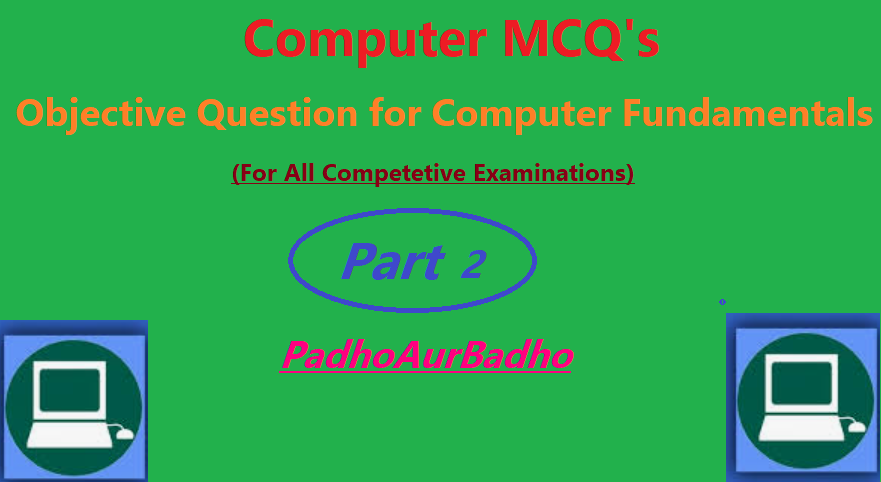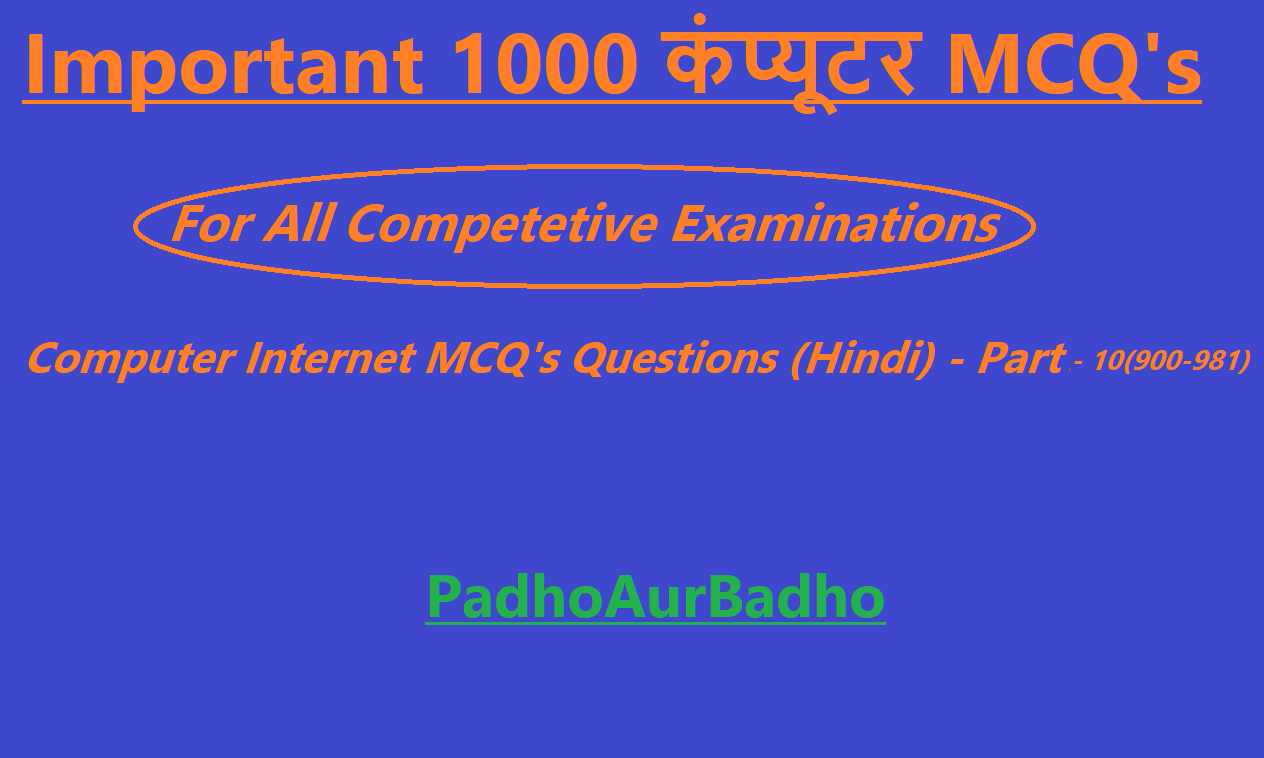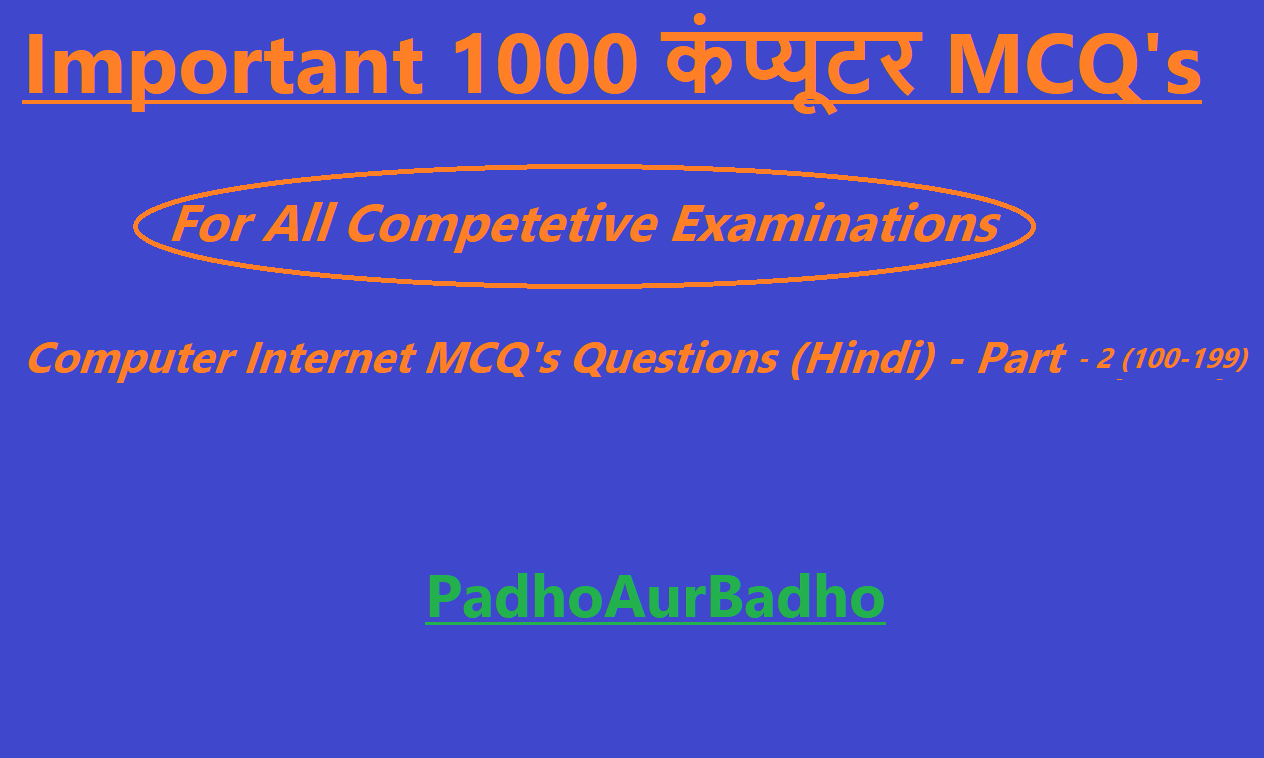दोस्तों आपलोग अगर General Competition परीक्षाओं की तयारी करते हैं तो आप सभी को बता दूँ की Computer से related topics को यहां से पढ़ सकते हैं, यहां सभी परीक्षाओं के लिए Computer के महत्वपूर्ण Topics को कवर किया जाएगा| This is the second MCQ’s related to Computer Fundamentals. Please read the MCQ’s and try solve it from your end. Click on View Answer to check the correct Answer.
Important Computer MCQ for BIHAR Clerk Examination
Note – please let us know if you find any answer incorrect.
- Line printer speed is specified in terms of:
- LPM (Line per minute)
- CPM (Character per minute)
- DPM
- Any of the above
- None of these
B. CPM (Character per minute)
2. The example of non-impacts printers are:
- Laser-Dot matrix
- Inkjet-Laser
- Inkjet-Dot matrix
- Dot matrix
- None of these
B. Inkjet-Laser
3. Which one is not impact printers option?
- Laser printer
- Dot matrix
- Daisy wheel
- Either(b) or (c)
- None of these
A. Laser printer
4. The CRT is in shape
- Circular
- Rectangular
- Eclipse
- Conical
- None of these
B. Rectangular
5. CRT is a:
- Hollow tube
- Vacuum tube
- Long tube
- Round tube
- None of these
B. Vacuum tube
6. As compare to CRT, the flat panel Display requires:
- Less power
- Low operating voltage
- Less clarity
- Both a and b
- None of these
D. Both a and b
7. CRT stands for:
- Copper Rod /Tube
- Cathode Ray Tube
- Completely Ready Tube
- All of the above
- None of these
B. Cathode Ray Tube
8. Graphical devices which are widely used to represent the graphics on
screen are:
- CRT
- Flat panel
- Touch screen
- Both a and b
- None of these
D. Both a and b
9. WORM stands for:
- Write Once Read Memory
- Wanted Once Read Memory
- Wanted Original Read Memory
- Write Original Read Memory
- None of these
A. Write Once Read Memory
10. Which of the following is a temporary primary memory
- PROM
- RAM
- ROM
- EPROM
- None of these
B. RAM
11. Which of the following is a sequential access device
- Hard disk
- Optical disk
- Tape
- Flash memory
- None of these
C. Tape
12. MICR stands for
- Magnetic Ink Character recognition
- Magnetic Ink Computer Record
- Magnetic Industries Corporation region
- Microphone Recording
- None of these
A. Magnetic Ink Character recognition
13. Program on which of the following storage device is always virus free
- Hard Disk
- Floppy Disk
- Compact Disk
- Any of these
- None of the above
E. None of the above
14. Which of the following can hold maximum data
- Optical disk
- Floppy Disk
- Magnetic Disk inside computer
- Magnetic Tape
- None of these
D. Magnetic Tape
15. A storage that supplements the primary internal storage of a computer
- secondary storage
- back-end storage
- back ground storage
- primary storage
- None of the above
A. secondary storage
16. Which of the following device can store large amount of data?
- Floppy Disk
- Hard Disk
- CD ROM
- Zip Desk
- DVD
B. Hard Disk
17. The ability to read or write each piece of information in a storage device in approximately the same length of time regardless of its location is
- Random Access
- Raster scan
- Sequential Access
- Any of the above
- None of the above
A. Random Access
18. Which of the following is handy to carry yet can store large amounts of data?
- Floppy Disk
- Hard Disk
- CD ROM
- Zip Desk
- DVD
E. DVD
19. Data (Information) is stored in computers as:
- Directories
- Files
- Floppies
- Matter
- None of these
B. Files
21. Which of the following statements is/are true?
- Cache Memories are bigger than RAM
- Cache Memories are smaller than RAM
- ROM are faster than RAM
- Information in ROM can be written by users
- None of these
B. Cache Memories are smaller than RAM
22. MOS stands for
- Most Often Stored
- Metal Oxide Semiconductor
- Method Organised Stack
- All of the above
- None of the above
B. Metal Oxide Semiconductor
23. MTBF means
- Mean Time Before Failure
- Mean Time Buffer Feature
- Most Treated Buffer Time
- Master Test Board Feature
- None of these
A. Mean Time Before Failure
25. The Analytical Engine developed during first Generation of computers
Used as a memory unit.
- RAM
- Floppies
- Cards
- Counter Wheels
- None of these
D. Counter Wheels
26. Size of the Primary memory of a PC ranges between
- 2 KB to 8 KB
- 64 KB to 256 KB
- 20 KB to 40 KB
- 256 KB to 640 KB
- None of these
D. 256 KB to 640 KB
27. Which of the following devices have a limitations that we can only read information to it but can not erase or modify it?
- Floppy Disk
- Hard Disk
- Tape Drive
- CD-ROM
- None of the above
B. Hard Disk
28. Memory is made up of:
- Set of wires
- Set of circuits
- Large number of cells
- Any of these
- None of these
D. Any of these
29. Primary Memory stores:
- Data
- Programs
- Results
- All of the above
- None of the above
D. All of the above
30. Memory Unit is a part of:
- Input Device
- Control unit
- Output Device
- Central Processing Unit
- None of these
B. Control unit
31. The contents of information are stored in:
- Memory Data Register
- Memory Address Register
- Memory Access Register
- Memory Arithmetic Register
- None of these
A. Memory Data Register
32. Which one is not the option of secondary storage device?
- Magnetic disk
- Hard disk
- Read only memory
- Floppy disk
- None of these
C. Read only memory
33. RAM stands for:
- Real Available Memory
- Random Access Memory
- Read all Memory
- Readily Available Memory
- None of these
B. Random Access Memory
34. How many write cycles are allowed to a RAM?
- 1
- 10
- 100
- 1000
- None of these
A. 1
35. RAM:
- is memory built from silicon chips that is used to store programs and data temporarily while they are being processed.
- is an acronym for Random-Access-Memory
- Both a and b are correct
- Readily Assigned Memory
- None of the above
C. Both a and b are correct
36. Information stored in RAM need to be:
- Check
- Refresh periodically
- Modify
- Detecting errors
- None of these
B. Refresh periodically
37. Read only memory is permanently____________ in computers.
- Input
- Tapped
- Sealed
- Manufacture and control
- None of these
A. Input
38. PROM supplied by the manufacturer as
- Half filled
- Blank
- With a booklet
- Partially filled
- None of these
B. Blank
39. EEPROM stands for:
- Electrically Erased Programmable Read Only Memory
- Electrically Erased Permanent Resident Of Memory
- Especially Erased Programmable Read Only Memory
- Encoded Erased Programmable Read Only Memory
- None of these
A. Electrically Erased Programmable Read Only Memory
40. EPROM can be used for:
- Erasing the contents of ROM
- Reconstructing the contents of ROM
- Erasing and reconstructing the contents of ROM
- Duplicating the ROM
- None of these
C. Erasing and reconstructing the contents of ROM
41. How many write cycles are allowed to a EEPROM?
- 1
- 10
- 100
- 1000
- None of these
D. 1000
42. The programs which are as permanent as hardware and stored in ROM is known as:
- Hardware
- Software
- ROMware
- Firmware
- None of these
D. Firmware
43. Programs stored in ROM are called:
- Hardware
- Firmware
- Software
- All of these
- None of these
B. Firmware
44. Full form of DSHD (used for floppy disks) is:
- Double Sided Head Drive
- Double Sided High Density
- Double Standard High Density
- Double Score High Density
- None of these
B. Double Sided High Density
45. All sectors on a floppy disk are bigger than tracks there:
- Always
- Only boot sector
- Only sectors on the periphery
- Only sectors at the center
- Never
E. Never
46. Which of the following is not a valid capacity of a floppy disk?
- 360 KB
- 720 KB
- 24 MB
- 44 MB
- None of these
C. 24 MB
47. Which of the following is not a valid size of a Floppy Disk?
- 8″
- 51⁄4″
- 31⁄2″
- 51⁄2″
- None of these
B. 51⁄4″
48. Floppy Disk Drives were first introduced by which of the following com-puter manufacturers?
- IBM
- Sony
- Panasonic
- Compaq
- None of these
A. IBM
49. Floppy Disk Drives were originally designed by:
- IBM
- Sony
- Panasonic
- Compaq
- Samsung
B. Sony
50. The floppy disks are:
- Cheaper
- Portable
- Least weight
- All of the above
- None of the above
D. All of the above
Read More:
– Computer Fundamental MCQ’s – Part 1– For Latest news refer to Onlinenewzs/*54745756836*/



